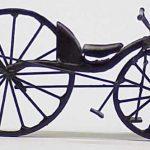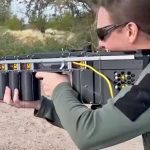 History
History  History
History  Weird Stuff
Weird Stuff 10 Fascinating Things You Might Not Know About Spiders
 Food
Food 10 Everyday Foods You Didn’t Know Were Invented by the U.S. Military
 History
History 10 Odd Things Colonial Americans Kept at Home
 Weird Stuff
Weird Stuff 10 Superstitious Beliefs That Once Consumed Entire Cultures
 History
History 10 Bizarre Friendly Fire Incidents in Military History
 Technology
Technology 10 Modern Technologies That Accidentally Imitate Ancient Magic
 Mysteries
Mysteries 10 Mysteries of the Human Genome
 Weird Stuff
Weird Stuff 10 Things So Rare They’ve Only Been Found Once
 History
History 10 Legends Whose Last Moments Undid Their Glory
 History
History 10 Great Escapes That Ended Right Back in Captivity
 Weird Stuff
Weird Stuff 10 Fascinating Things You Might Not Know About Spiders
 Food
Food 10 Everyday Foods You Didn’t Know Were Invented by the U.S. Military
Who's Behind Listverse?

Jamie Frater
Head Editor
Jamie founded Listverse due to an insatiable desire to share fascinating, obscure, and bizarre facts. He has been a guest speaker on numerous national radio and television stations and is a five time published author.
More About Us History
History 10 Odd Things Colonial Americans Kept at Home
 Weird Stuff
Weird Stuff 10 Superstitious Beliefs That Once Consumed Entire Cultures
 History
History 10 Bizarre Friendly Fire Incidents in Military History
 Technology
Technology 10 Modern Technologies That Accidentally Imitate Ancient Magic
 Mysteries
Mysteries 10 Mysteries of the Human Genome
 Weird Stuff
Weird Stuff 10 Things So Rare They’ve Only Been Found Once
 History
History 10 Legends Whose Last Moments Undid Their Glory
Ten Amazing Inventions by Catholic Priests
The common impression, especially among non-believers, is that science and religion oppose each other. The persecution of the astronomer Galileo for his heliocentric theory stands out as a prominent example of how the Catholic Church, in some cases, suppressed scientific inquiry it deemed detrimental to the faith.
But such episodes can be considered anomalies. For much of its history, the Church encouraged scientific thinking. It was no accident that the scientific method—observation, experimentation, and mathematical formulation—arose in Western Europe as it did. The Church had made European culture fertile ground for the Scientific Revolution. Even today, the Vatican runs the Pontifical Academy of Sciences, which counts the world’s most brilliant scientists as its members, including the late Stephen Hawking, an avowed atheist.
In fact, many scientists who contributed to the advance of scientific knowledge were Catholic priests. They never felt that doing science was incompatible with their religious vocation. The Church has given us a stellar list of scientist-priests and their accomplishments. Who hasn’t heard of Augustinian monk Gregor Mendel, the father of modern genetics? Or Fr. Georges Lemaitre, the formulator of the Big Bang theory?
In the practical application of science, priests have also left us their legacies. Priests have come up with inventions that helped build our modern technological society. Here is a list of ten of those inventions.
Related: Top 10 World-Changing Inventions You Didn’t Know Were Scottish
10 Automobile
Before Benz, Daimler, and Maybach, there was Ferdinand Verbiest. If we define “automobile” as a self-propelled vehicle not necessarily designed to carry a passenger, this Belgian Jesuit takes credit for its invention.
Born in 1623 in Pitthem in what was then the Spanish Netherlands, Ferdinand inherited the love of learning from his father, Joos. Considered a “singular prodigy” as a child, Ferdinand joined the Society of Jesus and studied philosophy, theology, mathematics, and astronomy. Upon receiving his doctorate in 1655, the Jesuits assigned Verbiest to their mission in China. Under the name Nan Huairen, Verbiest worked as a diplomat, astronomer, cartographer, mathematician, and translator for the Chinese emperor.
It was for Emperor Kangxi’s entertainment that Verbiest designed his automobile in 1672. It was only 26 inches (65 cm) long and could not carry a human driver, but it realized all the principles of “automobility.” A round boiler heated by a fire underneath produced steam that was then funneled through a pipe into an open steam turbine, which moved the rear wheels. This much was described by Verbiest in his work Astronomia Europea, but no plans or drawings have been found. However, a team of mechanical engineers from Technischen Hochschule in Ingolstadt, Germany, recently recreated a replica and demonstrated the feasibility of Verbiest’s contraption.[1]
9 Hot Air Balloon
Most people would find a soap bubble rising in the midst of the warm air around a burning candle to be an unremarkable sight. But not Bartolomeu Laurenco de Gusmao. It caused the Brazilian priest to wonder about the different densities of air and toy with the notion that an object lighter than air could take off the ground and fly. It was not the first time de Gusmao showed a scientific bent. At the age of 20, he invented a device that could fetch water from a stream and carry it up a hill 328 feet (100 meters) high. Even after his ordination, Fr. Bartolomeu went on to Lisbon to study mathematical science, astronomy, mechanics, physics, chemistry, and philosophy at Coimbra University.
When Fr. Bartolomeu announced that he had created a flying machine, Portugal’s King Joao V invited him to present it to the royal court. On August 3, 1709, he launched a small paper balloon fueled by heated air on the palace grounds, but it caught fire before it could take off. A second attempt two days later was successful, and so was a third one three days later.
While Fr. Bartolomeu’s design could not carry a human aloft, his idea that hot air could be used to make lighter-than-air craft was a significant milestone in the story of human flight, preparing the way for the first manned ascent in the Montgolfier balloon in 1783.[2]
8 The “Immortal” Battery
Guinness World Records calls it “the world’s most durable battery.” It is powering a bell at Clarendon Laboratory in Oxford University, which has been ringing (albeit inaudibly) nonstop since at least 1840, perhaps even 15 years before that. The battery is a dry pile, one of the first electric batteries ever invented, created by Italian priest Giuseppe Zamboni in 1812.
The Zamboni pile consisted of 2,000 discs of tin foil glued to paper soaked in zinc sulfate and coated on the other side with manganese oxide. It was not literally “dry,” as the moisture in the paper served as the conductor. Sufficient electromotive force could be obtained by these discs stuffed into a glass tube. With his batteries, Zamboni built a device consisting of a pendulum placed between two piles. Each pile attracted the pendulum alternately, resulting in a regular back-and-forth motion, which legend says continued on for a century.
A similar mechanism may be behind the Oxford bell. However, scientists prefer to wait until the bell finally stops before they take it apart and examine it.[3]
7 Induction Coil
Fr. Nicholas Callan pursued science for the sake of knowledge, not fame. This is why he is often overlooked as the inventor of the induction coil, the main component of modern transformers, which is usually attributed to Heinrich Ruhmkorff.
Callan was born in 1799 in County Louth, Ireland, and educated at the Catholic college in Maynooth. Physics, especially electricity and magnetism, fascinated him, even more so after he met the two great pioneers in the field, Luigi Galvani and Alessandro Volta, during his sojourn in Rome for his doctorate in divinity. Callan returned to Maynooth in 1827, dividing his time between teaching physics at his alma mater, writing religious books, and doing science experiments.
Lacking proper instruments in his basement lab, Callan would habitually give non-lethal doses of electricity to unsuspecting students as a way to gauge its voltage strength, with which he once knocked unconscious the future Archbishop of Dublin. Another time, he invited a team of strongmen to play tug-of-war with an electromagnet powered by a battery he built by linking 577 smaller batteries—the largest created up to that time.
In 1837, during the course of his experiments, Fr. Callan discovered the principle of mutual induction to produce over 60,000 volts of electricity, the largest then seen, and in so doing, invented the induction coil. Without the induction coil, many of the scientific advances of the 19th century—the discovery of radio waves, x-rays, the electron—would not have been possible.
Callan also patented a process of galvanizing iron to protect it from rust in 1853. The next year, he invented the Maynooth fluid cell battery, which used cast iron instead of expensive platinum, making batteries more affordable to researchers. He might have been one of the first to drive an electric vehicle, a small trolley with an electric motor he used to go around his lab.[4]
6 Electric Motor and Dynamo
In 1821, Michael Faraday demonstrated that electromagnetism could be converted into mechanical energy and created the first primitive electric motor. Faraday also showed that the reverse was also true, that mechanical energy could be transformed into electricity in building the first dynamo.
The relationships between electrical, magnetic, and mechanical forces fascinated the Hungarian Benedictine priest and physicist Anyos Jedlik, and he began experimenting with electric motors in 1827. Jedlik improved upon Faraday’s motor by eliminating Faraday’s permanent magnet and replacing it with a rotor, stator, and commutator—the three basic components of a modern DC motor. While Faraday’s motor had no practical application, Jedlik’s device showed the potential of electricity in doing work.
In 1861, Fr. Anyos created a “unipolar inductor” based on the principles of the Faraday dynamo six years before Werner Siemens and Charles Wheatstone published their “dynamo-electric principle.” Jedlik’s great innovation was using two opposed electromagnets to induce a magnetic field around the rotor—the principle of self-excitation. However, Jedlik did not make his invention public, so Siemens and Wheatstone took the credit.[5]
5 Internal Combustion Engine
The invention of the internal combustion engine is often credited to either French-Belgian engineer Etienne Lenoir in 1859 or the German Nicolaus Otto in 1861 only because their engines were the first to succeed commercially. However, the very first working model was actually devised in 1856 by Italian Fr. Eugenio Barsanti.
Barsanti belonged to the Order of Poor Clerics Regular of the Mother of God of the Pious Schools or Piarists, the oldest Catholic religious order dedicated to education. It was while teaching at the Collegio San Michele in Volterra that Fr. Eugenio had the idea that the explosive power of combustible gases could be harnessed to move the pistons in a motor. Barsanti teamed up with engineer Felice Matteucci to realize his concept, and the resulting two-cylinder, 5-horsepower motor was followed in 1858 by a two-piston engine designed to drive machinery in factories or even replace steam as a power source for ships.
Barsanti and Matteucci were already in negotiations with a plant in Liege, Belgium, to mass produce the engine when Fr. Eugenio was stricken with typhoid fever and died on April 16, 1864. Matteucci lacked the business skills to market their invention and lost out to Otto, despite his protests that Otto’s engine was similar to theirs. Defeated by the business-minded Otto, Matteucci dropped out and returned to being a hydraulic engineer.[6]
4 Fax Machine
Working among assorted odd devices and contraptions, one would think Giovanni Caselli was a mad scientist rather than a priest. When it came to physics, religion took a backseat for this native of Siena, Italy.
While teaching physics at the University of Florence, Caselli turned his attention to the problem of sending images and pictures through wires. The Scotsman Alexander Bain created a crude device for this purpose in the 1840s but did not fully exploit the idea. The main challenge was to synchronize the transmitter and receiver, which Bain, a clockmaker, ironically failed to solve.
Fr. Caselli used a regulating clock to address the synchronicity problem. Furthermore, he used ordinary ink to recreate the transmitted image, an improvement over Bain’s device, which scratched the picture onto a metal plate. Caselli’s pantelegraph (combining “pantograph”—a device for copying text and drawings—and “telegraph”) could reduce or enlarge the image and send multiple messages through a single wire at one time. The apparatus, the forerunner of the modern fax machine, was a monstrosity 6 feet (1.8 meters) tall, with pendulums, batteries, and wires.
The pantelegraph impressed Emperor Napoleon III so much that he ordered a fax service to connect Paris and Lyons, which was set up on May 16, 1865. Two years later, a fax connection to Marseilles was established. All these, we must remember, a decade before Alexander Graham Bell invented the telephone in 1876.
Aside from the fax machine, Caselli also invented the cinemograph ( a device that measures the speed of trains), a nautical electric torpedo, and a hydromagnetic rudder. He died in Florence in 1891.[7]
3 Barocyclonometer
Father Jose Maria Algue was a Spanish Jesuit ordained in 1888 who studied astronomy, seismography, and meteorology at the University of Barcelona beginning in 1890. He arrived in the Philippines to work under Father Federico Faura, founder of the Observatory of Manila. Algue succeeded as director of the observatory upon Padre Faura’s death in 1897 and stayed on even after Spain ceded the Philippines to the United States.
Algue lent his expertise to the Americans and worked part-time with the U.S. Weather Bureau. The region’s tropical typhoons presented a danger to U.S. ships surveying and mapping the new colony. Algae invented the barocyclometer in 1897, a device that undoubtedly saved many lives in the era before satellite tracking. It combined a fluidless barometer and cyclonometer. The barometer gave a warning of a cyclone to a ship based on changes in atmospheric pressure, and the cyclonometer allowed the captain to calculate where the storm was and where it was headed by means of mathematical formulas and tables.
Algue modified the barocyclometer for use in the North Atlantic, and the U.S. Navy adopted it in 1914 to evade the fierce hurricanes in the ocean. The priest also invented the nephoscope, a device to determine the motion of clouds, and a microseismograph that could detect microquakes caused by storms at sea.[8]
2 Bulletproof Vest
In 1893, Chicago Mayor Carter Harrison I was shot and killed in his own home by a deranged assassin. The death of the popular mayor grieved many, none more so than Casimir Zeglen, a Polish immigrant and parish priest of St. Stanislaus, the largest Polish church in the U.S. He determined to prevent such future tragedies by creating a bulletproof vest.
Before the assassination, Zeglen had already been experimenting with material that could stop bullets but, at the same time, be lighter than the traditional metal plate. Among the materials he tried were steel shavings, moss, and hair, all of which proved unsatisfactory. A doctor named George Goodfellow discovered that silk significantly reduced a bullet’s penetration but failed to follow it up. Zeglen picked up where the good doctor left off and started working with silk.
On March 16, 1897, Fr. Casimir, wearing his silk bulletproof vest, faced a man with a loaded revolver at a public square in Chicago. In front of witnesses, including the mayor, the man fired several bullets at the priest, who staggered at the impact but was otherwise unharmed. His bulletproof vest worked! Zeglen was actually lucky to survive. A silk vest had to be precisely sewn to deflect bullets, and Zeglen’s hand-sewn version was dangerously inadequate.
The increasing power of bullets made the silk bulletproof vest obsolete by 1913. But the idea that fabric can be bulletproof remains Zeglen’s legacy. It has since been adopted to manufacture better protective armor for more durable synthetic fabric.[9]
1 Wireless Audio Transmission
The world remembers Guglielmo Marconi for his wireless telegraph. But the genius Brazilian inventor who did to the human voice what Marconi did to Morse code has been largely forgotten. Roberto Landell de Moura deserves better as the pioneer of radio broadcasting and wireless phones.
Landell was an inquisitive child, reading voraciously about everything, be it biology, physics, or astronomy. But under the influence of his family, he took up a religious vocation and studied for the priesthood. However, Landell never lost interest in science, also studying physics and chemistry at the Gregorian University in Rome. It was while returning home to Brazil in 1886 that Landell realized that it was possible to send the human voice great distances through the air.
Marconi unveiled his wireless telegraph in 1895 while Landell was seeking to secure funding for his project. The Church did not support him—people felt he was straying from his priestly duties. He managed to borrow $4,000 ($ 100,000 today) from a New York merchant, a debt that crippled him for many years.
On July 16, 1899, Father Landell began transmitting from Santana College north of Sao Paulo to Bandeiras Bridge, 2.5 miles (4 kilometers) away. “Play the National Anthem,” Landell exulted as the magic of science carried the words to the receiver in the first-ever public demonstration of his device. It consisted of a spark-gap generator with a Ruhmkorff coil and two metallic spheres that produced the radio waves. To modulate the carrier wave, Landell devised a diaphragm coupled to a pair of electrical contacts inside a resonant chamber, which he called a “phonetic switch.” The modulation process Landell invented is now known as amplitude modulation (AM).
Fr. Landell struggled to find investors for his wave transmitter, which was patented in the U.S. and Brazil in 1901, but he got nowhere. His patent expired, and the priest retreated into obscurity, dying unrecognized in 1928. His invention, now in the public domain, became the model for other scientists working with radio.[10]








